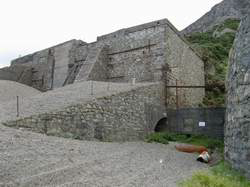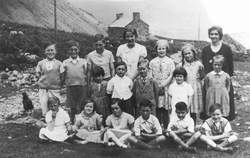Abandoned Communities ..... Porth y Nant
We will move on to the 1930s, the decade before the quarry was closed and the village started to be deserted. By then there was much less demand for granite setts, but granite blocks were still needed for tunnels and bridges, and crushed stone for such uses as railway ballast and road building. At the rock face gunpowder was used to break up the stone, which was subsequently broken down further by drilling and hammering. The stone would be loaded into wagons, and pushed down a tramway to the top of a steep chute. Having emerged at the bottom of the chute the stone would go through a powerful crushing machine and then piled up in the storage hoppers to await loading onto a steamer.
This process, and the titles and job descriptions of the various workers employed at the quarry, are described in vivid detail in chapter 23 of Eileen Webb’s book, This Valley is Ours, originally published in 1983, but published again in a new edition in 2007 by Gwasg Carreg Gwalch. The book also gives a lot of information about the way of life of people living in Porth y Nant during the 1930s.
Eileen Webb, who was the daughter of the quarry manager, Mr T H Salmon, attended the small school at Porth y Nant. During the 1930s there were about twenty pupils and a single teacher, Mrs Roberts. The main language at the school was Welsh, English being taught as a subject. Some children would stay at the school until they reached the school leaving age of 14. Others would move on to the County School in Pwllheli. They would have to climb the hill each morning and catch a bus at Llithfaen.
The school consisted of just one room at the end of the chapel. There was a large stove in one corner of the room. Eileen Webb recalled that the girls would jostle for a place close to the stove on cold mornings, but unless the temperature was very low the boys would prefer to appear tough by staying away from it. Most of the work was done on slates with slate pencils, paper and writing books being kept for more special work. Playground areas were available both in front of the chapel and behind it.
The isolation of Porth y Nant meant that shopping presented several challenges. There was a grocery in Llithfaen, and sometimes people would make the trip to Pwllheli. Mail order was another option, and occasionally women may have booked a voyage on a visiting steamer to travel to Liverpool.
Some purchases, however, were made in Porth y Nant itself. A Mr Jones came from Llithfaen with catalogues and samples of his goods. Two others, known as Evan Wynne and George Matt, operated part time shops in the village. They would bring their goods down the hill on a horse drawn sledge. The sledges, which were used for various other purposes as well, were renowned for the screeching sounds they produced as their metal runners passed over the more rocky parts of the track.
There was no mains gas, electricity, or water in Porth y Nant. Water came from a reservoir on the hill above the village. On one occasion a car plunged off a track at the top of the hill and petrol leaking from it entered the reservoir. The villagers had to rely on rain water until the reservoir was flushed clear of petrol.
By the 1930s there were two telephones in the village, one of them in the manager’s house. Eileen Webb’s father would sometimes have to pass on urgent messages to other members of the community. Eileen Webb recalled the time when her father had to inform Mr and Mrs William Owen that their 15 year old daughter Bessie had been killed. Bessie and a friend had asked for a ride on motorbikes that had then skidded into each other in icy conditions and collided with a wall.
This process, and the titles and job descriptions of the various workers employed at the quarry, are described in vivid detail in chapter 23 of Eileen Webb’s book, This Valley is Ours, originally published in 1983, but published again in a new edition in 2007 by Gwasg Carreg Gwalch. The book also gives a lot of information about the way of life of people living in Porth y Nant during the 1930s.
Eileen Webb, who was the daughter of the quarry manager, Mr T H Salmon, attended the small school at Porth y Nant. During the 1930s there were about twenty pupils and a single teacher, Mrs Roberts. The main language at the school was Welsh, English being taught as a subject. Some children would stay at the school until they reached the school leaving age of 14. Others would move on to the County School in Pwllheli. They would have to climb the hill each morning and catch a bus at Llithfaen.
The school consisted of just one room at the end of the chapel. There was a large stove in one corner of the room. Eileen Webb recalled that the girls would jostle for a place close to the stove on cold mornings, but unless the temperature was very low the boys would prefer to appear tough by staying away from it. Most of the work was done on slates with slate pencils, paper and writing books being kept for more special work. Playground areas were available both in front of the chapel and behind it.
The isolation of Porth y Nant meant that shopping presented several challenges. There was a grocery in Llithfaen, and sometimes people would make the trip to Pwllheli. Mail order was another option, and occasionally women may have booked a voyage on a visiting steamer to travel to Liverpool.
Some purchases, however, were made in Porth y Nant itself. A Mr Jones came from Llithfaen with catalogues and samples of his goods. Two others, known as Evan Wynne and George Matt, operated part time shops in the village. They would bring their goods down the hill on a horse drawn sledge. The sledges, which were used for various other purposes as well, were renowned for the screeching sounds they produced as their metal runners passed over the more rocky parts of the track.
There was no mains gas, electricity, or water in Porth y Nant. Water came from a reservoir on the hill above the village. On one occasion a car plunged off a track at the top of the hill and petrol leaking from it entered the reservoir. The villagers had to rely on rain water until the reservoir was flushed clear of petrol.
By the 1930s there were two telephones in the village, one of them in the manager’s house. Eileen Webb’s father would sometimes have to pass on urgent messages to other members of the community. Eileen Webb recalled the time when her father had to inform Mr and Mrs William Owen that their 15 year old daughter Bessie had been killed. Bessie and a friend had asked for a ride on motorbikes that had then skidded into each other in icy conditions and collided with a wall.
Two
Porth y Nant quarry
The storage bunkers
More debris, and the view south towards Carreg y Llam quarry
School photograph, taken in 1938. Eileen Webb (née Salmon) is in the back row, next but one to Mrs Roberts.



